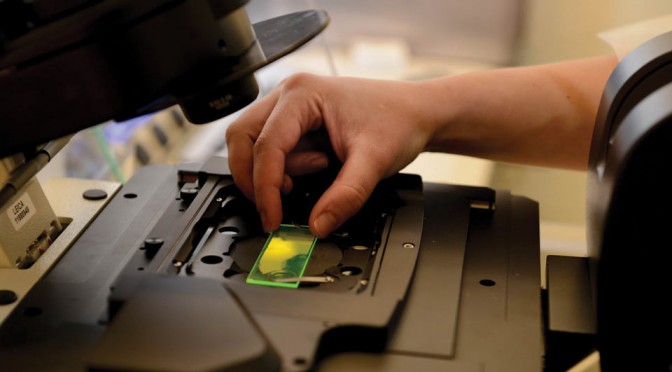As a promising young scientist, Lynda Bonewald got plenty of advice from researchers with far more experience in the field of bone and mineralized tissue research.
They told her not to waste time on the osteocyte, the most common bone cell. Sure, they were plentiful, she was told, but not influential. All structure, no function. The action in bones took place on the surface, not buried deep in the interior where the osteocytes dwelled.
Powerful microscopes and cutting-edge technologies by Bonewald’s group revealed long extensions projecting from osteocyte cells, like the dendrites that connected nerve cells. That implied function, and Bonewald says she was determined to discover what that function was.
Today, decades and millions of dollars in research grants later, Bonewald is one of the leading bone scientists in the world. She leads a team of international researchers at UMKC who are following up promising evidence indicating that osteocytes function in a manner similar to endocrine organs, sending vital coded messages through the musculoskeletal system. Unlocking the remaining secrets of the osteocyte could open the door to treatments and cures for osteoporosis, a disease of low bone mass predisposing to fracture, brittle bone disease and other painful, crippling and often fatal diseases associated with aging.
Thanks to her pioneering efforts, the osteocyte is now the focus of much bone research around the world, a major target for development of therapeutics to prevent bone loss, treat osteoporosis, prevent fractures and accelerate bone healing.
In her current primary project, she is principal investigator for a five-year, $8.3 million program project grant from the National Institute on Aging, part of the National Institutes of Health, to study the relationship between osteoporosis and sarcopenia (loss of muscle mass) as people age. The research focuses on how bone and muscle cells biochemically communicate with each other in health and disease.
Then there’s a “side project” she is working on with her chemistry colleagues: a 21st century bone cement, for use in joint replacement and other surgeries, that represents a potential billion-dollar entrepreneurial opportunity.
“Each year, more than 1 million Americans undergo joint replacement surgeries. As the baby boom generation ages, that figure will increase substantially,” Bonewald says. “Those surgeries require the use of bone cement to attach the artificial joint replacement to the surrounding bone. But the cement commonly used for those procedures damages the surrounding bone, causing pain, and requiring additional procedures.
“With our knowledge of bone structure and function, we are developing a new bone cement without these damaging side effects. The new bone cement is a major advance on the bone cement that has been used for over 40 years for hip and knee replacement.”
Is a glue-like putty the next Gatorade?
University of Florida researchers invented Gatorade, the popular sports drink in 1973. Since then, it’s estimated that the Gatorade Trust has earned more than $150 million in royalties for the university, allowing it to invest in dozens of health research programs.
A marble-sized sample of the new bone cement that Bonewald and her team have developed can solidify into a nearly rock-hard state within 15 minutes. The current cement commonly used for hip replacements or knee replacements has been used for more than 40 years.

